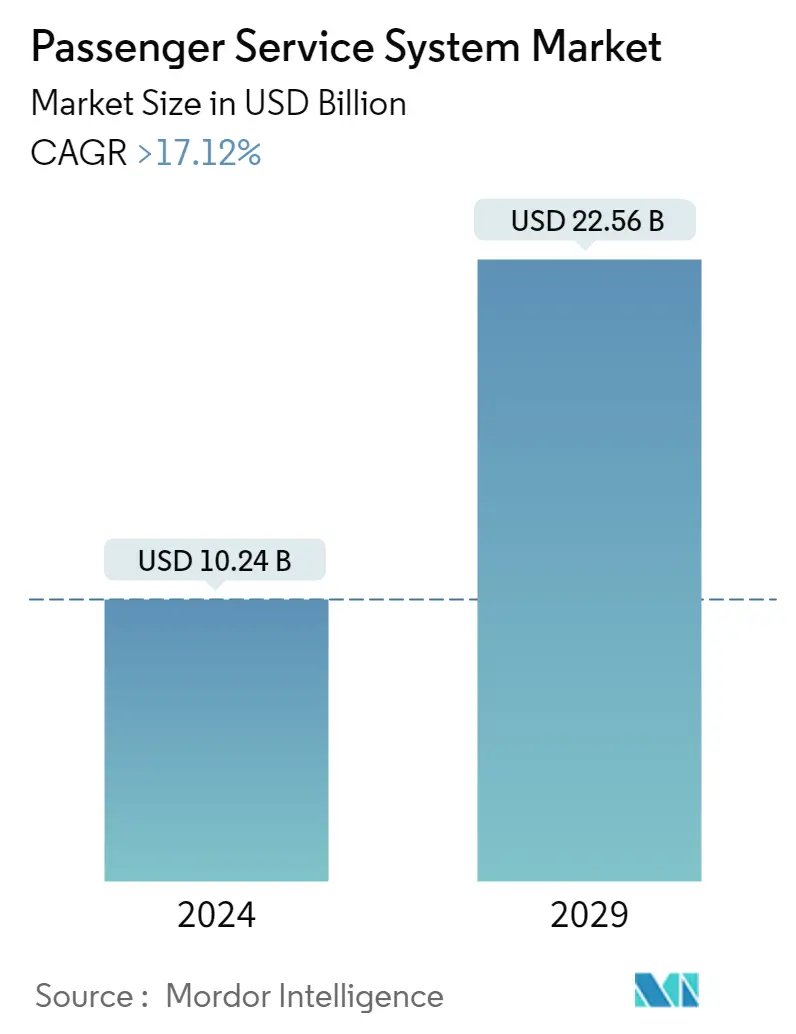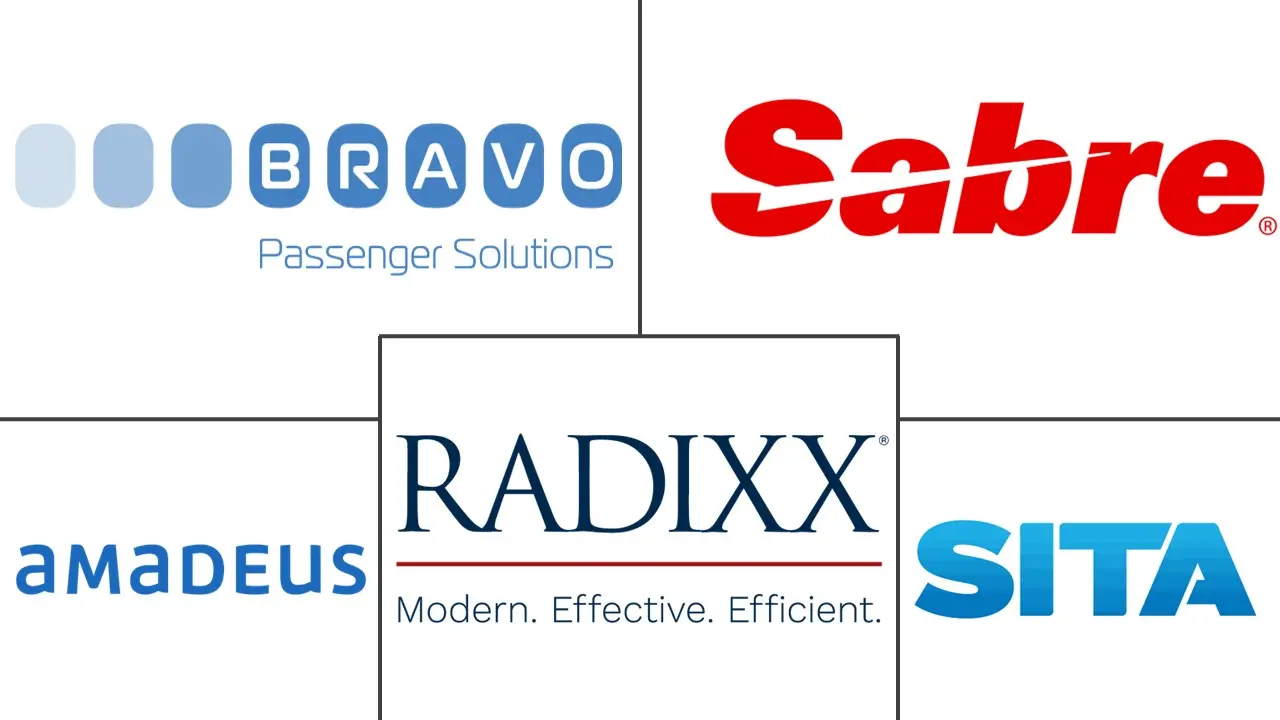Market Size of Passenger Service System Industry

| Study Period | 2019 - 2029 |
| Market Size (2024) | USD 10.24 Billion |
| Market Size (2029) | USD 22.56 Billion |
| CAGR (2024 - 2029) | 17.12 % |
| Fastest Growing Market | Asia Pacific |
| Largest Market | North America |
Major Players
*Disclaimer: Major Players sorted in no particular order |
Passenger Service System Market Analysis
The Passenger Service System Market size is estimated at USD 10.24 billion in 2024, and is expected to reach USD 22.56 billion by 2029, growing at a CAGR of greater than 17.12% during the forecast period (2024-2029).
With the emergence of low-cost carriers (LCC) and a growing number of air passengers, the need for an efficient and mission-critical system for passenger service management is increasing. Thanks to the increasing income levels of customers and the availability of low-cost aviation, tickets are becoming more affordable every day for a broad base of potential customers. For instance, according to the International Civil Aviation Organization (ICAO), in 2018, LCCs carried an estimated 1.3 billion passengers, accounting for approximately 31% of the world's total scheduled passengers.
- Although the passenger service system (PSS) aims to develop a single homogeneous solution, the need for airlines to differentiate their products is hindering this possibility. Despite this, many airlines have included PSS in their standard operating procedures due to the aviation industry's fast adoption of information technology. The advent of online booking, inventory control, and reservation services has greatly automated airline operations.
- In May 2023, Vix Technology has announced a partnership with myBus, a Barcelona-based transit SaaS provider, to bring its cloud-native passenger information and fleet management system to the UK and USA. With the myBus solution, operators can manage their networks in real time, address any gaps in service, and provide passengers with up-to-date information on their journey."
- Furthermore, In May 2023, Travel Technology Interactive (TTI) and carbon click, have announced partnership to work towards a more sustainable future for aviation.This collaboration will deliver the first end to end carbon offset IBE solution, which will be integrated into a single PSS. Traditionally, a barrier for individual airlines has been the long period of time and considerable costs to implement comprehensive solutions with which they are confronted, making it very difficult for many air carriers around the world to adopt end interoperability programs at this stage.
- Although the COVID-19 pandemic slowed down international passenger travel, the market for airline passenger service systems expanded quickly as governments simplified their current operating capabilities, which encouraged the use of smart solutions. Airports were able to operate smoothly throughout the pandemic thanks to these advancements.
Passenger Service System Industry Segmentation
The passenger service system market is segmented by software and services. The basic modules offered in the software are the reservation system, inventory management, and departure control system. The deployment model depends on the scale of adoption and the infrastructure required to support it.
The passenger service system market is segmented into type (software, service), deployment (on-premise, cloud), and geography (North America, Europe, Asia Pacific, Latin America, and Middle East and Africa). The report offers market forecasts and size in value (USD) for all the above segments.
| By Type | |
| Software | |
| Services |
| By Deployment | |
| On-premise | |
| Cloud |
| Geography | |
| North America | |
| Europe | |
| Asia-Pacific | |
| Latin America | |
| Middle East & Africa |
Passenger Service System Market Size Summary
The Passenger Service System (PSS) market is experiencing significant growth, driven by the increasing demand for efficient and integrated solutions in the airline industry. As low-cost carriers gain popularity and air travel becomes more accessible, the need for robust passenger service management systems is becoming critical. The aviation sector is rapidly adopting advanced information technologies, such as online booking and inventory control, to streamline operations and enhance customer experiences. Despite challenges in creating a unified solution due to the need for product differentiation among airlines, the market is witnessing a surge in the adoption of PSS as airlines strive to improve service delivery and operational efficiency. Partnerships and collaborations, such as those between Vix Technology and myBus, and Travel Technology Interactive with Carbon Click, are further propelling the development of innovative and sustainable PSS solutions.
The market landscape is semi-consolidated, with leading vendors like SITA NV and Amadeus IT Group playing pivotal roles in shaping the industry. These companies are focusing on developing cutting-edge PSS solutions to meet the evolving needs of airlines and their passengers. The ongoing digital transformation in the aviation sector is encouraging airlines to adopt vertical integration strategies, developing in-house PSS to enhance their service offerings. Notable developments, such as Sabre Corporation's renewal of agreements with JetBlue and Oman Air, and the launch of new systems like IBS Software's iFly Res, highlight the industry's commitment to leveraging technology for improved passenger experiences and operational efficiency. As global air travel continues to rebound, particularly in regions like Asia, the demand for sophisticated PSS is expected to rise, supported by significant investments in infrastructure and technology.
Passenger Service System Market Size - Table of Contents
-
1. MARKET DYNAMICS
-
1.1 Market Overview
-
1.2 Industry Attractiveness - Porter's Five Forces Analysis
-
1.2.1 Threat of New Entrants
-
1.2.2 Bargaining Power of Buyers/Consumers
-
1.2.3 Bargaining Power of Suppliers
-
1.2.4 Threat of Substitute Products
-
1.2.5 Intensity of Competitive Rivalry
-
-
1.3 Introduction to Market Drivers and Restraints
-
1.4 Market Drivers
-
1.4.1 Rise in Air Travel Passengers
-
1.4.2 Increased Adoption of IoT and Connected Devices at Airports
-
-
1.5 Market Challenges
-
1.5.1 High Initial Capital Investment to Create Supporting Infrastructure
-
-
-
2. MARKET SEGMENTATION
-
2.1 By Type
-
2.1.1 Software
-
2.1.2 Services
-
-
2.2 By Deployment
-
2.2.1 On-premise
-
2.2.2 Cloud
-
-
2.3 Geography
-
2.3.1 North America
-
2.3.2 Europe
-
2.3.3 Asia-Pacific
-
2.3.4 Latin America
-
2.3.5 Middle East & Africa
-
-
Passenger Service System Market Size FAQs
How big is the Passenger Service System Market?
The Passenger Service System Market size is expected to reach USD 10.24 billion in 2024 and grow at a CAGR of greater than 17.12% to reach USD 22.56 billion by 2029.
What is the current Passenger Service System Market size?
In 2024, the Passenger Service System Market size is expected to reach USD 10.24 billion.

